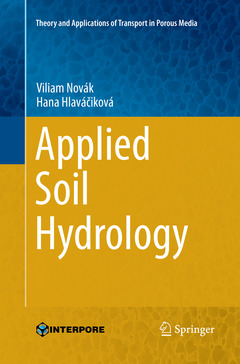Description
Applied Soil Hydrology, 1st ed. 2019
Theory and Applications of Transport in Porous Media Series, Vol. 32
Authors: Novák Viliam, Hlaváčiková Hana
Language: English
Subjects for Applied Soil Hydrology:
Keywords
Soil moisture; Soil Water; Soil Water Movement; Hydrophysical Characteristics of Soil; Meteorology; evapotranspiration; soil hydrology; soil-water potential; soil-water retention; soil hydraulic conductivity; water-resource formation; soil-water flow modeling; retention of stony soils; water repellent soils; hydrogeology; water quality and water pollution
Publication date: 12-2019
342 p. · 15.5x23.5 cm · Paperback
126.59 €
In Print (Delivery period: 15 days).
Add to cartPublication date: 11-2018
Support: Print on demand
Description
/li>Contents
/li>Biography
/li>Comment
/li>
Soil as part of the Soil-Plant-Atmosphere System (SPAS).- Basic physical properties of soils.- Physical properties of water.- Phenomena on the interface water - solid phase of soil.- Soil water content, methods of measurement.- Soil - water potential and its measurement.- The soil water retention curve.- Flow of water in unsaturated, rigid, capillary - porous media (soil).- Flow of water in variably saturated soil.- Infiltration.- Redistribution of water in homogeneous soil.- Groundwater - soil water interactions.- Evapotranspiration of water.- Solute transport in porous media and in soils.- Water and energy balance in the field and soil water regime.- Swelling and shrinking soils.- Stony soils.- Water repellent soils (hydrofobic soils).- Soil air and its dynamics.- Soil temperature and heat transport in the soils.- Modeling the transport of water and solute in soils.




